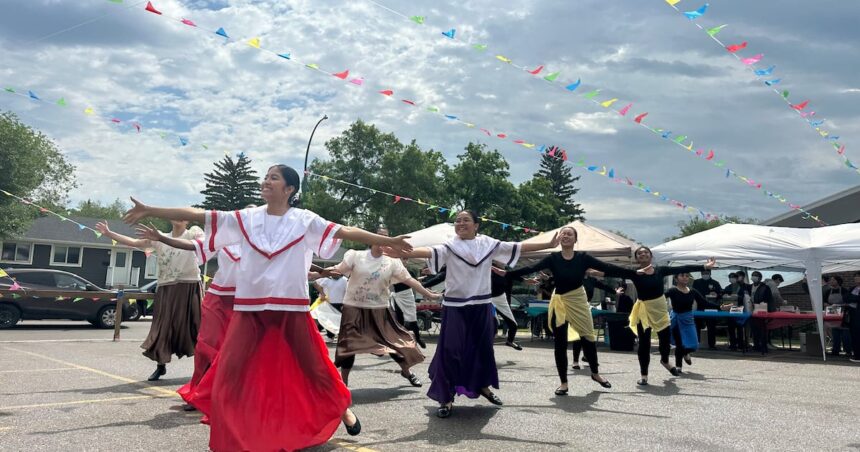I woke to the scent of lechon and the rhythmic sounds of tinikling dance rehearsals filtering through Regina’s Cathedral neighborhood. For the city’s growing Filipino community, the day promised not just celebration, but a profound expression of cultural identity. The 2024 Pinoy Fiesta had transformed the quiet park into a vibrant tapestry of color and movement.
“This is how we keep our traditions alive, even thousands of kilometers from home,” Maria Santos told me, adjusting the intricate beadwork on her traditional terno dress. At 68, she’s been part of Regina’s Filipino community since 1985, watching it grow from a handful of families to nearly 10,000 strong.
The annual Pinoy Fiesta in Regina has evolved into more than entertainment – it’s become a cultural lifeline connecting generations. This year’s celebration, centered around both cultural heritage and religious tradition, drew over 2,000 attendees from across Saskatchewan.
“Many of our children were born here. They’re Canadian, but we want them to understand where their parents and grandparents came from,” explained Father Antonio Delgado, who presided over the morning’s special mass at Holy Rosary Cathedral before the festivities began.
The morning blessing transitioned into an afternoon of cultural immersion. Young dancers performed the singkil – carefully navigating between clapping bamboo poles – while others demonstrated the pandanggo sa ilaw, balancing oil lamps on their heads with remarkable poise. The precision of these performances revealed countless practice hours, but also the community’s dedication to preserving traditional arts.
What struck me most was the seamless blend of sacred and secular. The celebration honored Santo Niño, the child Jesus figure deeply revered in Filipino Catholicism. Elaborately dressed statues of the Santo Niño stood at a central shrine where visitors offered prayers throughout the day. Yet just meters away, children raced through inflatable obstacle courses while teenagers performed K-pop dance routines, illustrating how this community embraces both heritage and contemporary influences.
Food vendors created perhaps the most tangible connection to the Philippines. Steam rose from massive paelleras of pancit, while the crisp skin of lechon (roast pig) crackled under carving knives. I watched as ninety-year-old Lola Carmen guided her Canadian-born great-granddaughter through the proper technique for wrapping lumpia.
“You must fold it tight, like a little blanket,” she instructed gently. “This is how my grandmother taught me.”
The economic impact of the festival extends beyond cultural significance. According to Regina’s Economic Development office, cultural festivals generate approximately $3.2 million annually for the local economy. The Filipino community, representing one of Saskatchewan’s fastest-growing immigrant populations, contributes significantly to this figure.
Regina Mayor Sandra Masters attended the opening ceremonies, acknowledging the Filipino community’s contributions to the city. “Events like Pinoy Fiesta remind us that Regina’s strength comes from our diversity,” she noted. “The Filipino community has enriched our city through their entrepreneurship, healthcare work, and cultural traditions.”
Community leader Roberto Gonzales, who helped coordinate this year’s event, emphasized the practical support systems that operate within the celebration. “Beyond the performances and food, this is where newcomers can connect with established community members who can help with employment, housing, and navigating Canadian systems,” he explained.
A resource booth staffed by Filipino-Canadian professionals offered information on everything from credential recognition to winter driving tips. I noticed several recent arrivals exchanging contact information with potential employers and housing connections.
The healthcare presence was particularly notable. Saskatchewan Health Authority representatives conducted health screenings in Tagalog and English, while Filipino healthcare workers volunteered their time. This practical element acknowledges the significant representation of Filipinos in Saskatchewan’s healthcare workforce – approximately 30 percent of internationally educated nurses in the province come from the Philippines, according to Saskatchewan Association of Registered Nurses data.
As evening approached, the festival shifted tone. Older attendees gathered under tents to share stories and play traditional card games, while younger generations performed contemporary Filipino music on the main stage. The musical selections blended traditional kulintang gong music with modern OPM (Original Pilipino Music) and even Filipino-Canadian fusion artists.
University student Jasmine Reyes, born in Regina to Filipino parents, performed original songs that reflected her dual identity. “I don’t see it as choosing between being Filipino or Canadian,” she told me after her set. “My music explores what it means to be both simultaneously.”
Watching families traverse the festival grounds, I noticed the fluid language shifts between English, Tagalog, Ilocano, and Cebuano. Children responded to Tagalog questions in English, while parents navigated between languages with unconscious ease – a living demonstration of cultural adaptation.
As dusk fell and lanterns illuminated the grounds, I found myself beside Elena Rodriguez, watching her grandchildren perform traditional dances they’d learned at the Filipino Heritage School, a weekend program run by volunteers.
“When I first came to Regina in 1997, I worried my grandchildren would never know these traditions,” she reflected. “Now look – they’re the ones preserving our culture. They’re adding their own interpretation, but the heart remains Filipino.”
The Pinoy Fiesta continues to grow each year, with organizers already planning 2025’s celebration. What began as a small gathering in church basements has blossomed into a significant cultural event that strengthens community bonds while inviting wider Regina to participate.
As I left the festival grounds, the final performances still underway, I carried with me a deeper understanding of how cultural celebrations serve as both anchor and bridge – connecting communities to their roots while building new connections in their adopted home. In Regina’s evolving cultural landscape, the Pinoy Fiesta stands as testament to the enduring power of heritage maintained through collective celebration.






